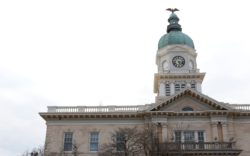The Athens-Clarke County Commission heard an update on a 1.6-mile, $4.3 million shared-use path along Timothy road at a work session last week that could be built in 2025, but county officials and citizen advisors also have ideas for smaller bike and pedestrian projects that can be completed cheaply and quickly.
Five initial projects in the Athens in Motion plan include King Avenue sidewalks (already completed) and multi-use paths along Barber Street, Riverbend Road, Jefferson Road and Cherokee Road (which is currently unfunded but could be paid for with a tax allocation district along Lexington Road). Each is a multimillion-dollar project that has taken years to plan.
“We felt strongly about the need for innovative thinking—the fact that these projects have taken a long time to deliver,” interim Transportation and Public Works Director Rani Katreeb told commissioners at their Oct. 10 work session. “In the meantime, we are aware of local needs, small needs, smaller projects that can be completed much faster than larger projects.”
Such projects include filling in sidewalk and bike lane gaps, Americans with Disabilities Act improvements, complete streets projects that improve bike and pedestrian safety, pilot projects like the initially temporary bike lanes on Prince Avenue or grant matching funds.
Filling in a sidewalk gap would only cost about $50,000, but would have a big impact on people walking to work or school, Bicycle and Pedestrian Safety Coordinator Daniel Sizemore said.
The same goes for gaps in bike lanes, for example on Oglethorpe Avenue near Sunset Drive. There is currently no budget for such projects, but $1 million would fill two bike lane gaps a year for five years, Sizemore said. These would not be major reconfigurations, but could involve moving curbs or removing unneeded turn lanes like one on Rocksprings Street that is no longer used by Clarke Central High School buses, he said.
“Many community members have told us they would be more comfortable biking and walking, and if they’re more comfortable biking and walking, they would be driving less,” Sizemore said.
Sizemore also suggested taking an inventory of ADA barriers like utility poles blocking ramps at intersections. Utility companies could be required to make such improvements as part of their periodic franchise negotiations with ACC to use the public right-of-way, Katreeb said.
Pilot projects could include “bulb-outs” that force drivers to slow down while turning near areas like schools or bus stops with high pedestrian traffic. “We’re trying to make sure we can test innovative solutions and evaluate the impact before we roll those out on our major roadways,” Sizemore said.
Transportation officials also asked for a bucket of money for lane reconfigurations—converting space for cars into space for bikes and pedestrians—when streets are repaved. Encouraging people to use other types of transportation instead of driving is a very effective way to reduce traffic congestion, Sizemore said.
“It’s important to note that our goal is not to get everyone to walk or bike everywhere. We know cars are important—I used one to get here [to City Hall] today,” he said. “The goal here is to give safe transportation options for those who want to use those options or those who fully depend on them for various reasons.”
After data is collected, each of the six individual programs—sidewalk gaps, bike lane gaps, complete streets, pilot projects, ADA compliance and grant matching—will be brought to the mayor and commission for approval.
Municipal Broadband: While there are other reasons to build a municipal broadband network—redundancy for critical services in case of an emergency, for example—the gaps in service for residents are much smaller now than when the commission included it in a 2019 sales tax referendum, SPLOST and information technology officials told commissioners.
Building a full-blown network would cost an estimated $127 million, but only $3.6 million is available. The county is looking to use that money to partner with a third-party service provider.
However, right now only 1% of county residents lack access to broadband internet, according to the Federal Communications Commission’s National Broadband Map. Residents can check the map to see if they have access, and they can also file a challenge with the FCC if the map says service is available but companies tell them differently, SPLOST Administrator Derek Doster said.
And the remaining 1% should have broadband access soon. Service providers are using federal American Rescue Plan Act grants to expand into the last remaining serviceless pockets along the Jackson County line, around Winterville and in rural southeastern Clarke County, Doster said.
Memorial Park: Pending approval from the commission next month, ACC officials have settled on keeping a one-way loop around the lower end of Memorial Park as part of a $6 million SPLOST renovation project, while the upper parking lot will be converted to two-way. The pond will be dredged and repaired so that hopefully it will no longer fill up with silt. Grant funding is being sought for a new pavilion and other amenities that no longer fit into the budget.
Whit Davis Fire Station: A site selection committee has proposed three alternatives for replacing 49-year-old Fire Station #5, currently located on Whit Davis Road. The two top-ranked sites are both on Morton Road south of Old Lexington Road, and the third is on Old Lexington just west of Morton. However, none of the sites scored well on ACC’s matrix, and all three were overwhelmingly panned by the public. A formal recommendation will come prior to the commission’s Nov. 7 meeting.
Like what you just read? Support Flagpole by making a donation today. Every dollar you give helps fund our ongoing mission to provide Athens with quality, independent journalism.










